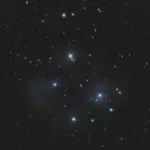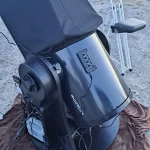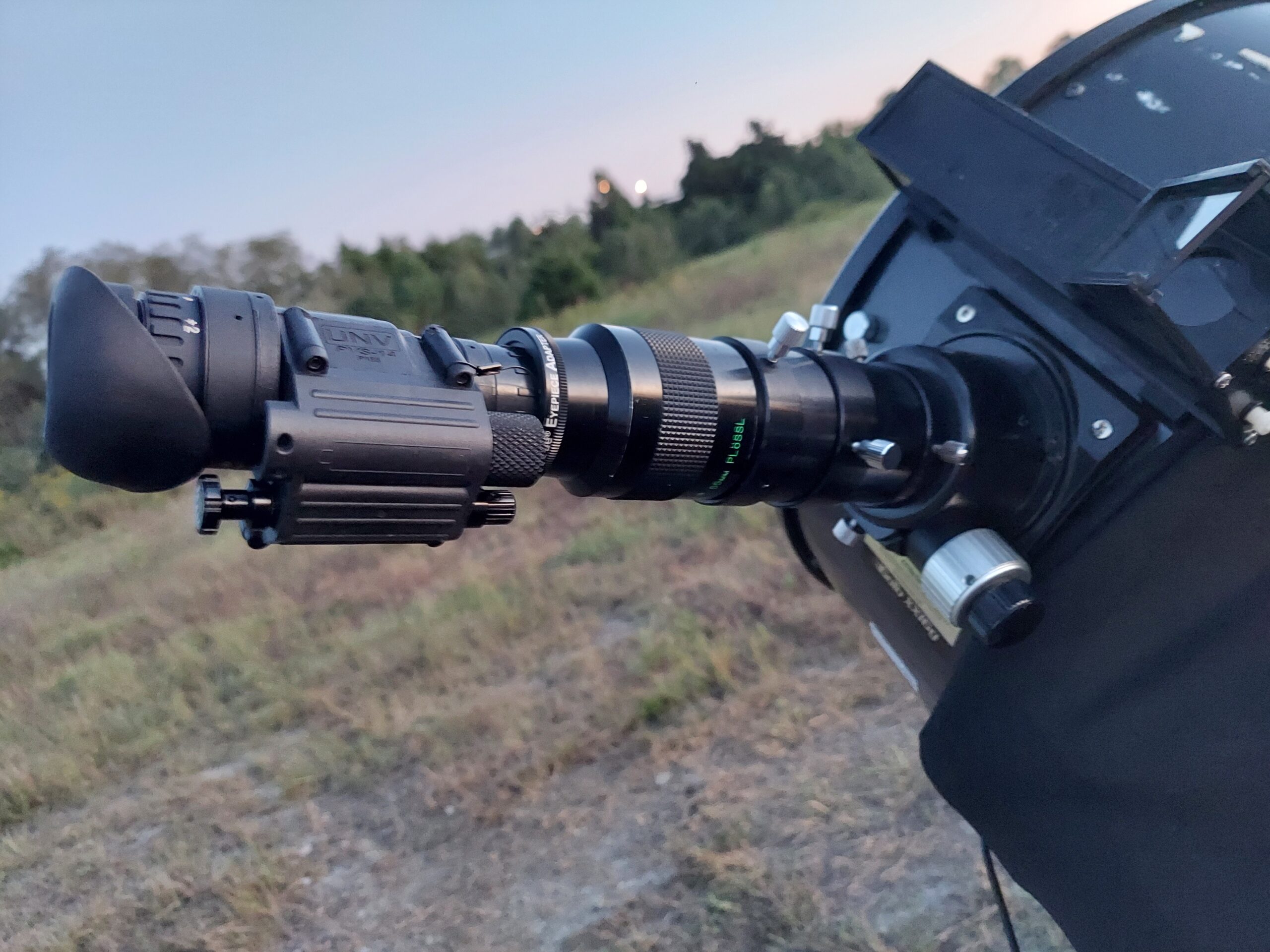When you start looking into astronomy there are a lot of things to learn. I learned quickly that I would need something to prevent dew from forming on my mirrors and eyepieces.
Active dew control means using tools and devices to control the temperature of your telescope to discourage the formation of dew. Tools like dew heaters, eyepiece warmers, cooling fans, finderscope warmers, secondary mirror warmers and dew shields are all part of active dew control. Depending on your telescope you may need one or all of these tools to effectively combat dew.
Most of these things also require electricity, so you will need a way to power them. I bought a Dynamo Pro portable power bank. This allows me to connect everything to power when I am in the field.
If you have to use multiple of these devices, be aware that you will need to manage the cords carefully. They can become tangled, pull and disconnect when slewing the scope.
Active dew control is most important when the temperate and the dew point are within 5 degrees of one another.
This is when you are most likely to have dew form on your telescope.
Why does dew form on telescopes?
There is always some moisture in the air, this is measured by dew point. The dew point is the temperature the air would need to be cooled to in order for dew to form.
Higher the dew point the more water is in the air.
The optical surfaces of your telescope are glass. These surfaces cool faster than wood or plastic, the air around them cools quickly. This provides an ideal surface for the water in the air to stick to.
When looking at the weather on a night you plan to observe, check to see how close the dew point is to the ambient temperature.
I use Astrospheric to monitor the weather, here is a screenshot that shows that you will have a lot of trouble with dew tonight:
The temperature and the dew point are just too close together. That means the water in the air is already almost about to become dew on any surface it comes in contact with.
Dew point also indicates how humid a day will feel to you. That condensation will happen on your body if the dew point is high enough.
Pros and Cons of Active Dew Control
You will learn quickly if humidity is going to be a problem where you live. I have friends in Florida who have to fight humidity every night.
Living in a humid area you have to have a solid set up for dew control. I am adding to my setup with a new eyepiece warmer and improving the connections on my dew heater.
The pros are obvious, a good setup keeps dew off your optical surfaces.
When you are considering all these additions to your telescope there are some cons to consider:
The need for electricity
Once you introduce telescope warmers you will need a source of electricity.
I chose to purchase a Dynamo Pro which I can charge at home and bring with me. It can also plug into my car and I can power it that way.
You can also choose battery packs with rechargeable batteries.
The weight it will add
Adding things like cooling fans, dew heaters and other warmers will add weight to your setup. If you are traveling with your telescope often this can be a major issue.
The failure of components
When you have real dew issues, you need to have backups. These electronic components fail. Everything fails at some point.
I travel with my scope so it is very disappointing when I get to a location only to find I have to cut my night short because of dew.
I have heard that a battery powered hair dryer is a great addition to your kit.
How to use a dew heater
Dew heaters are flexible strips with velcro to easily adjust them. Some people call them dew straps.
These can be wrapped around your finderscope, secondary mirror or eyepieces. On an SCT you can attach it directly behind the lens cell.
Be sure that the dew strap is touching all surfaces equally with no gaps, because a gap will cause uneven heating and it may not be effective in keeping the surface clear.
Once the device is secured to the telescope you need to power the device, some run on USB batteries and can be used with a power bank, otherwise you will need some way to get electricity to the heater.
I chose to purchase a Dynamo Pro, but battery banks are another option.
Keep the device on a low setting at all times, especially if you are imaging which requires a long exposure time.
Many astronomers use a control switch to raise and lower the temperature of the strip. This is a pretty advanced project and I have not even considered it. These control boxes are often DIY 3d printed masterpieces.
It is not necessary to create an external control box. Many units come with some level of control. It is just as good to leave the heaters on at a low temperature during the entire observing session.
There is some concern that heating the secondary mirror too high can cause the glue that holds the mirror in the scope to weaken or even fail. I spoke to a representative at R-Sky and he assured me that he has never seen this happen.
If you are still getting dew with a dew heater, turn up the heat until your optical surfaces are clear.
My dew heater failed because of a poor electrical connection. I bright the broken dew heater to my father in law who is an electrician. We took it apart and are working to rewire the heat controller.
I lost one input into the control box.
Keep your system simple whenever possible.
Is a dew shield necessary?
A dew shield extends the cushion of air in front of a mirror. This has an insulating effect which slows the change of temperature and discourages dew formation.
I have never needed to use a dew shield because I have always used Dobsonian telescopes, the optical tube acts as a dew shield.
I have seen setups with large dew shields on all types of telescopes, but I have not found it necessary.
Dew shields are inexpensive, simple tools to help control dew. They also block stray light if you are in a light polluted area.
It is worth a try if you have trouble with dew or light pollution.
A dew shield can be purchased from most of the major telescope manufacturers, but they are also easily constructed with craft foam, cardboard or even stiff paper.
As a general rule, the length of the dew shield should be 1.5 times the diameter of the objective lens. This maximizes efficiency while reducing the negative impacts on your field of view.
Which Telescopes Need Dew Shields
SCT (Schmidt Cassegrain Telescope) and Mak (Maksutov) telescopes almost always benefit from a dew shield while Dobsonian telescopes rarely do. The difference is the construction of the telescope. Dobsonians are built inside a large optical tube that insulates the mirrors.
SCTs and MAC telescopes are types of refractor scopes. Their construction does not create an insulating layer of air around the optics. The use of a dew shield can reduce the dew accumulation and create better observing conditions.
If you are having trouble with dew, no matter what your equipment, a dew heater is a simple, inexpensive, low tech tool to try.
Other Ideas for Dew Prevention
During my time observing there are some other things I have found to be helpful to combat dew.
Hot Hands and Rubber Bands
Before I had a real dew heater I bought a bunch of Hot Hands and attached them to my scope with rubber bands. It only works for a few hours and it does not heat evenly, but it can make a difference for a new observer.
I keep a few Hot Hands in my gear every time I go out, it could be what it takes to salvage a night if my electronics fail.
Box Fan
A box fan at an appropriate distance could provide a light breeze which could keep dew from accumulating on your scope.
The movement of air cools everything down and discouraged dew formation.
If you observe in a gravel lot like I do, this is not a great idea because you will just kick up dust.
Elevation
Dew forms more readily in valleys. If you are not able to combat the dew in your observing location. Move to higher ground.
The hills and mountains around a valley keep the moist air in place and does not allow it to escape. The water from all previous rainfall may also keep the soil more moist in the valley.
This is important to consider if you have made a big trip to a dark sky area and you are not willing to just pack up and wait for a more clear night.






